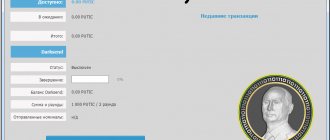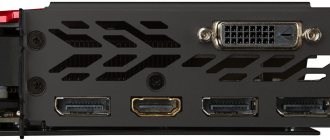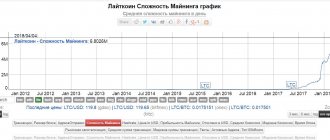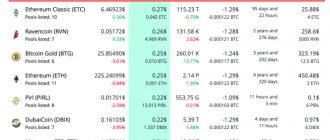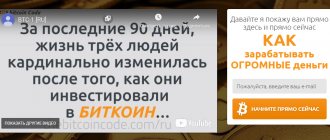Ethereum appeared on the cryptocurrency market in 2020, it was created by programmer Vitaly Buterin. Ethereum mining is very popular and today it ranks 2nd among mining platforms after Bitcoin, only Ethereum is easier to mine. With the increase in the number of miners, the difficulty of mining currency began to increase.
This problem plagues all electronic money, the operation of which is based on the Proof of Work protocol (proof of work performed). The miner provides the power of his equipment to receive a reward. The difficulty of mining Ethereum has its own distinctive features, it is worth considering in more detail.
What is network complexity?
Indicators characterizing the complexity of the Ethereum network (block difficulty) are indispensable for calculating the profitability of mining this cryptocurrency and they make it clear whether it is worth mining at all. The concept is used as a characteristic of the time required for block validation. For this value, there is a Nonce definition parameter, a hash, which, together with mixHash, is a confirmation that the required number of calculation operations have been performed for the block. The expected time to find it is called an indicator of the difficulty of mining cryptocurrency.
Ethereum hashing algorithm is Ethash, it sets the metadata of the last block in the blockchain network using the Nonce code. It is not possible to simply guess it, for this reason, the use of equipment with high computing power is necessary in order to encrypt the block and receive a reward. The indicators are adjusted automatically by the system, and they must all be in full compliance. The time spent on block validation is set when its complexity level is determined; if it turns out to be less than expected, the system will reduce the network complexity level.
Ethereum network complexity
The complexity of the Ethereum network is not much different from Bitcoin. The principle is the same - the more it is mined, the more difficult it is to get it.
By the way, the initial difficulty of ETH was much higher than average. This is due to the fact that the blockchain project was initially crowdfunded. Most of the mined coins were initially distributed to investors.
Etherium (as well as Bitcoin) has such an important parameter as block difficulty, which is based on the PoW (proof-of-work) consensus mechanism. The PoW algorithm shows changes in this parameter, which plays an important role for miners.
It is important for crypto traders and investors to be interested in this indicator, because the difficulty of mining has a direct correlation with the level of popularity. Simply put, the higher the difficulty of production, the higher the popularity, and therefore the capitalization and rate.
The ratio of difficulty and rate ensures the profitability of Ethereum.
What is a “complexity bomb”?
The “difficulty bomb” was invented by Ethereum developers as a way to make mining very difficult. Its purpose is to make cryptocurrency mining completely unprofitable in the required period of time. This step was needed by programmers as part of a plan to rebuild to Proof of Stake. The algorithm sets deadlines for changes to take effect and forces the system to go according to the plan invented by the programmers.
Important! In the summer of 2020, the network complexity level increased 200 times when compared to the initial level.
Mining Features
Ethereum and Ethereum Classic are mined using an algorithm that differs from that for Bitcoin mining. But the main principle of the process remains unchanged. To mine Bitcoin, you need specialized, expensive equipment; mining BTC using video cards is no longer profitable, and creating Asic farms is too expensive. Therefore, back in 2020, when Ether was very expensive, it then reached 9000% of the lowest value, a huge number of miners were attracted to the Ethereum system.
Until recently, the difficulty of mining ether grew slightly, because it was only possible to mine coins independently using a Geth wallet. This was quite difficult for a poorly prepared participant.
This situation greatly alienated most miners, despite the fact that the price of coins was attractive and mining brought good profits.
Today, Ethereum mining is still a profitable activity, since the cost of ETH and the capitalization of this electronic money are high. Experts suggest that the price of the currency will rise further. But for mining you need to have powerful equipment. The parameters of video cards must be selected correctly and ensure the required performance in order to successfully encrypt blocks. The hashrate of a video card depends on the following characteristics:
- Memory capacity (required from 4 GB).
- Speed (DDR5).
- Memory bus width of the video card (minimum 256).
- Cooling system.
- Overclocking capability.
The hashrate is also greatly influenced by the following factors:
- operating system and its features;
- type and type of device (farm or PC).
In order to correctly calculate how profitable the extraction of electronic monetary units will be, taking into account all circumstances without exception, it is worth using the following resources:
- WhatToMine;
- Nicehash.
Important! The complexity of the Ethereum network will only increase every month, and after the transition from POW to POS is made, mining will no longer affect the security and operation of the platform.
Today you shouldn’t start mining Ethereum from scratch; it’s better to mine coins in cloud services.
Why is Ethereum mining difficulty increasing?
There is a simple answer to this. When the developers created the cryptocurrency, they laid down a fixed number of coins that users would mine in a certain period of time. If users have mined more tokens than required, the difficulty of Ethereum mining increases. This is done to slow down emissions.
Conclusion! If a smaller amount of cryptocurrency is mined than required, then the difficulty is reduced and coins are mined easier and faster.
How quickly the difficulty increases
The Ethereum network is designed in such a way that new blocks are added to the chain approximately once every 10 minutes. Since everyone wants to make money, computing power is constantly growing. In this regard, there must be a certain parameter that compensates for such growth. This parameter is the complexity of the network; it is recalculated once every two weeks or every 2020 blocks. The rate of increase in network complexity cannot be predicted, but assumptions can be made. On average, it grows by 9% per month.
The uniqueness of the Ethereum network
The Ethereum network, according to many experts, is in many ways superior to the Bitcoin platform. The introduction of smart contracts, which make it possible to register transactions involving different assets, has greatly contributed to this. The Ethereum network also has a feature in the form of increased productivity of coin mining. In addition, transactions are processed at high speed and new blocks are generated quickly. In the Ethereum network you can get a stable profit from mining.
The mechanism for mining Ethereum coins is unique in its own way. As is the case with other cryptocurrencies, the difficulty of mining ETH is slowly but constantly increasing. But the platform’s programming team has planned a major innovation that will greatly affect the emergence of new coins.
The foundation for the upcoming changes was laid last fall with the help of a unique update called “Byzantium” - a “difficulty bomb”. It is required in order to switch from the familiar POW algorithm to Casper, the latest algorithm reminiscent of PoS. After the transition, mining will no longer be profitable, but this has not happened yet, and Ethereum mining still brings good profits.
History of difficulty changes
Since 2020, the number of miners in the Ethereum network has begun to increase rapidly. A well-developed infrastructure played a major role in this (the emergence of many pools, new wallets, as well as instructions). The Ethereum rate has increased by 9000% from its original price. This had a positive impact on coin mining; mining them became very profitable.
Almost immediately after this, the difficulty began to increase. This lasted throughout 2020 until the increase reached 3,000 terahash in October. The difficulty of mining tokens increased in line with the growth of the ETH rate. In 10 months of that year it grew from $10 to $300.
Afterwards, the difficulty of mining coins dropped to 1,500 terahash. This was influenced by the new Byzantium update. As mentioned earlier, it became the foundation for the “complexity bomb”. But despite everything, the growth in the value of Ethereum continued and reached its peak in January 2020. Then the price of the coin was fixed at $1,415. The period that lasted from October 2020 to January 2020 is the most profitable in the entire history of Ethereum mining.
Will a miner need a work schedule?
Yes, this is the main working tool for generating a token.
Based on the actual data of the chart, the miner monitors the dynamics of exchange rate growth and the profitability of mining at the moment.
The current Ethereum Classic difficulty development chart is also needed by crypto traders who conduct technical analysis.
By the way, in 2020, based on a technical analysis of the chart, one could notice how literally in 10 months, the cost of ETH increased from $10 to the maximum possible $300, despite the fact that an Ethereum hard fork occurred.
go
Current Ethereum mining difficulty
After the Byzantium update was released, the difficulty began to return. At the moment, this figure is 3183 terahashes, and this is despite the fact that the Ethereum rate has dropped significantly. At the end of April 2020, coins cost $400. This greatly affected mining profitability.
According to information obtained from the website coinwarz.com, Ethereum is the most profitable electronic currency for miners: having powerful equipment of 108 MHz/s, taking into account electricity consumption of 600 W per day at a price of $0.054/kWh, net earnings will be 3- $4 for 24 hours.
Important! If a miner does not have equipment with the highest computing power, then the high difficulty of mining will lead to the fact that he will not stay afloat.
ETH mining difficulty chart
If we analyze how the difficulty level of Ethereum mining has changed, then the graph of changes in this indicator over the entire existence of the platform looks like a progressively growing branch of a parabola with a certain flat section at the initial stage of the network’s activity.
Examining the formation period of the mining site in 2020, the difficulty value was about 1.2 terahash. Further, it was possible to increase the difficulty of the platform throughout 2020 within acceptable limits. This fact brought the cryptocurrency system its own “finest hour”, which allowed Ethereum to become one of the most profitable electronic currencies in 2020 and the beginning of 2020.
You can see the Ethereum difficulty chart online here
Then, from January 2020, the change in difficulty began to grow rapidly, and already in the summer this value reached 250 terahesh. After the difficulty mark reached 1200 terahesh, rapid increases in difficulty began to occur up to 3000 terahesh, with a sharp decline to 50%.
Analyzing the graph, a parallel question arises: why is the difficulty of extracting ethers increasing? What circumstances led to the constant growth of the ether itself? The influence of several factors, such as regular updates of algorithms, the number of interested miners and much more, has led to the fact that mining cryptocurrency is becoming much more difficult.
Forecast for 2020
Due to the fact that the developers of the Ethereum network promise to soon transfer coin mining to the Proof of Stake algorithm, there is no point in buying special, expensive equipment. It may happen that funds are spent on acquisitions, but it will not be possible to recoup them. It is much more efficient to spend money on purchasing as many Ethereum coins as possible.
But there is also one minus here. None of the specialists or ordinary users can guarantee that the POS algorithm will work in 2018, despite the promises of the developers. Also, no one knows what will happen to the tokens themselves if Proof of Stake starts working. Some experts argue that there is a high probability of a collapse in the Ethereum rate. After which it will be difficult to recover.
If a miner has a powerful cryptocurrency mining farm, then it is worth trying to extract the maximum possible number of coins before the end of the year. For now it is possible to do this. Those who do not have expensive equipment can do cloud mining. Thus, it will be possible to avoid unjustified expenses and the risk of recouping the invested funds. Of course, everyone must make their own decision, but it is worth considering all the factors before investing your personal savings.
If we soberly assess the current situation, we can see with the naked eye that the complexity of the network is constantly increasing. The update, called "Byzantium", prepares the blockchain to switch to the POS algorithm. In this regard, the “Ice Age” may soon occur - a certain stage of time when mining Ethereum will be simply impossible.
The reward for a mined block today has already decreased from 5 to 3 ETH. Thus, the developers are preparing the ecosystem for a new hard fork. If in the coming weeks or months the Ether rate becomes higher, then by the end of the year it will be possible to mine it, and if it goes down, then mining will become unprofitable.
Forecasts
Looking at the current chart, we can say that miners are going to be off to a low start. What does it mean? The difficulty is growing exponentially, and “Byzantium” became the “first sign” of the imminent transition to the PoS algorithm and the end of the era of Ethereum mining.
But this event will be preceded by the so-called “ice age”. It was planned for the fall of 2020, but for unknown reasons it was postponed.
Vitaly Buterin, the founder of the Ethereum network, commenting on this event, said that the “ice age” will pass very slowly, and each block will be created with a large interval. But everything can start much earlier, because according to analysts’ forecasts, the “complexity bomb” will be felt by the end of 2020. This will force the developers to carry out a new hard fork, during which the new algorithm will be introduced.
Now the reward for a mined block has already dropped from 5 to 3 coins. Mining will still be possible for some time, after which it will become unprofitable. But unprofitability is not liquidity. The price, demand and capitalization level will continue to increase for this crypto asset.
